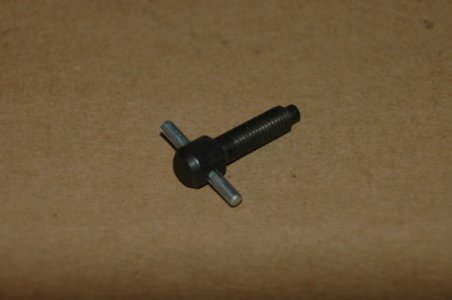- Joined
- Feb 13, 2017
- Messages
- 2,138
Any machine will have some backlash. That is a given. Mine is old and "loose" meaning in this case around .030. I often see more on other's. The best I've ever seen is .003. The best suggestion is that when it's fairly low, compensate for it and go on about business.
Gibs: They should be tight and evenly adjusted. As in all should have the same snugness. They should be so tight but not so much as to give trouble moving the whatever by hand. Pushing by hand, it should not be so loose that it moves when you bump it. But you don't want it so tight that it takes a pry bar or "come along". Tight and snug are very personal concepts. What you consider snug, I might consider tight. And a real machinist might consider loose. My machine (Craftsman 12") has wear in the center of the gibs. They are adjusted so they are snug on each end. But things are too loose in the middle. I found some knobs that fit hex capscrews. No link, this was way back BC. I have three gib screws down the side of the cross slide. I removed the center one, replacing it with a cap screw and one of the knobs. When I adjust for a cut, the screw is loosened, the slide moved, then the screw tightened finger tight. Just how tight depends on how I feel that day.
Leadscrew/Nut: When the machine is(was) new(or freshly ground), there was little or no play in the nut. This is in part from the gibs. The tighter the gibs, the faster the nut wears. That's why the nut is a softer metal. It wears rather than the screw. Up front, unless you have replaced the nut yourself, assume it to be worn. It will need replacing someday. When is a matter that you must decide. I have a couple of "zero backlash" devices in my mind. But they are far too large for a machine slide. The best one was for a plasma torch "X-Y" table I built for a friend. At 5 inches high and 4 wide, it would be a little too big for a lathe, even a shipyard lathe. A double nut with a spring in the middle would work. But how strong a spring? Best bet is to adjust in only one direction. For an inward adjustment, back out 100 thou and take it back in only 098.
.
Gibs: They should be tight and evenly adjusted. As in all should have the same snugness. They should be so tight but not so much as to give trouble moving the whatever by hand. Pushing by hand, it should not be so loose that it moves when you bump it. But you don't want it so tight that it takes a pry bar or "come along". Tight and snug are very personal concepts. What you consider snug, I might consider tight. And a real machinist might consider loose. My machine (Craftsman 12") has wear in the center of the gibs. They are adjusted so they are snug on each end. But things are too loose in the middle. I found some knobs that fit hex capscrews. No link, this was way back BC. I have three gib screws down the side of the cross slide. I removed the center one, replacing it with a cap screw and one of the knobs. When I adjust for a cut, the screw is loosened, the slide moved, then the screw tightened finger tight. Just how tight depends on how I feel that day.
Leadscrew/Nut: When the machine is(was) new(or freshly ground), there was little or no play in the nut. This is in part from the gibs. The tighter the gibs, the faster the nut wears. That's why the nut is a softer metal. It wears rather than the screw. Up front, unless you have replaced the nut yourself, assume it to be worn. It will need replacing someday. When is a matter that you must decide. I have a couple of "zero backlash" devices in my mind. But they are far too large for a machine slide. The best one was for a plasma torch "X-Y" table I built for a friend. At 5 inches high and 4 wide, it would be a little too big for a lathe, even a shipyard lathe. A double nut with a spring in the middle would work. But how strong a spring? Best bet is to adjust in only one direction. For an inward adjustment, back out 100 thou and take it back in only 098.
.

